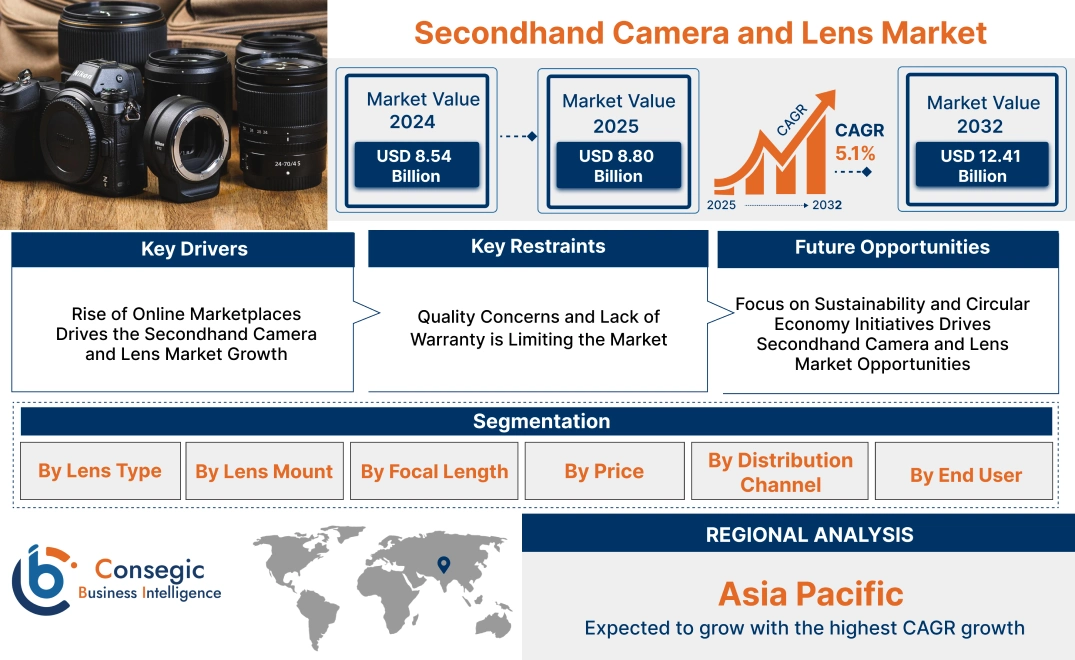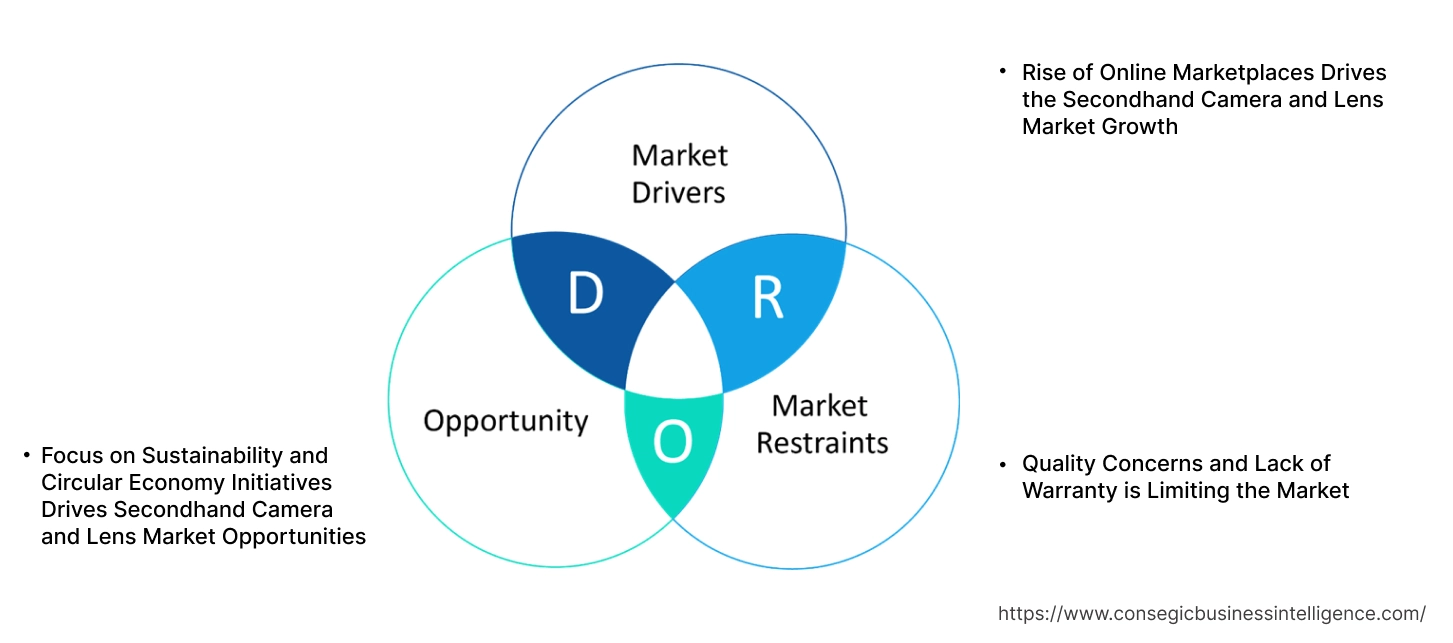- Summary
- Table Of Content
- Methodology
Secondhand Camera and Lens Market Size:
Secondhand Camera and Lens Market is estimated to reach over USD 12.41 Billion by 2032 from a value of USD 8.54 Billion in 2024 and is projected to grow by USD 8.80 Billion in 2025, growing at a CAGR of 5.1% from 2025 to 2032.
Secondhand Camera and Lens Market Scope & Overview:
Secondhand cameras and lenses refer to previously owned photographic equipment that is being resold, offering a more affordable alternative to new gear. The adoption of secondhand camera and lens is driven by factors including the increasing consumer awareness of sustainable consumption and the cost-effectiveness of purchasing pre-owned equipment. Furthermore, the continuous advancements in camera technology and the subsequent upgrades by photographers contribute to a consistent supply of quality used gear entering the market.
Key Drivers:
Rise of Online Marketplaces Drives the Secondhand Camera and Lens Market Growth
The rise of online marketplaces industry has significantly propelled the adoption of secondhand camera and lens by enhancing accessibility and convenience for both buyers and sellers. These platforms provide a wider reach than traditional brick-and-mortar stores, connecting a larger pool of individuals looking to buy or offload used equipment. Further, features like detailed listings, secure payment systems, and buyer/seller ratings build trust and facilitate transactions, overcoming geographical limitations and driving overall market expansion.
- For instance, KEH Camera specializes in providing a secure and reliable platform to buy and sell pre-owned photographic equipment, including cameras, lenses, and accessories.
Thus, growing trend of digitalization is resulting in the growth of online marketplaces which in turn drives the secondhand camera and lens market size.
Key Restraints:
Quality Concerns and Lack of Warranty is Limiting the Market
Quality concerns and the absence of a standard manufacturer's warranty act as significant barrier to the growth of secondhand camera and lens market. Potential buyers often hesitate due to the inherent risk of purchasing equipment with unknown usage history, potential hidden defects, or reduced lifespan compared to new items. Further, the lack of a comprehensive warranty leaves buyers vulnerable to repair costs and functional issues arising after purchase, creating a barrier to entry for those seeking guaranteed performance and reliability. This hesitation can steer consumers towards new products despite the cost savings offered by the secondhand market, limiting its growth, particularly among less experienced buyers.
Future Opportunities :
Focus on Sustainability and Circular Economy Initiatives Drives Secondhand Camera and Lens Market Opportunities
The increasing global focus on sustainability and circular economy initiatives presents significant opportunities for secondhand camera and lens. As environmental awareness grows, consumers are actively seeking ways to reduce waste and make more responsible purchasing decisions. Opting for pre-owned photographic equipment aligns perfectly with these values, extending the lifespan of existing products and minimizing the environmental impact associated with manufacturing new ones. This trend can be leveraged by businesses in the secondhand market through transparent sourcing, refurbishment programs, and marketing that highlights the ecological benefits of buying used gear. Thus, by embracing circular economy principles, the market can attract a growing segment of environmentally conscious consumers and foster long-term growth in turn driving the secondhand camera and lens market opportunities.
Secondhand Camera and Lens Market Segmental Analysis :
By Lens Type:
Based on the lens type, the market is segmented into standard lens, wide angle lens, telephoto lens, others.
Trends in the Lens Type:
- The need for wide-angle lenses in the secondhand market is growing due to their suitability for vlogging and photography, which is driving the secondhand camera and lens market trends.
- There’s a focus towards smaller and lighter wide-angle prime and zoom lenses which are expected to drive secondhand camera and lens market size.
Standard lens accounted for the largest revenue share of 36.49% in the year 2024.
- Standard lenses remain popular among beginners and casual photographers due to their versatility for everyday shooting, portraits, and general photography which is driving the secondhand camera and lens market share.
- Further, there’s a rising interest in older, manual focus prime lenses in the standard focal length which in turn drives the secondhand camera and lens market trends.
- Furthermore, increasing prevalence of high-quality kit lenses for mirrorless systems might put downward pressure on the prices of older DSLR standard zoom lenses, making them more affordable.
- For instance, B & H Foto & Electronics Corp. offers Canon RF 50mm f/1.8 STM Lens, which is a compact, lightweight standard lens designed for full-frame Canon RF mount cameras. It features a fast f/1.8 aperture, an STM stepping AF motor for smooth and quiet autofocus, a customizable control ring, and an aspherical element.
- Thus, as per secondhand camera and lens market analysis, rising popularity of vlogging and affordability of the lens are driving the market.
Telephoto lens is anticipated to register the fastest CAGR during the forecast period.
- Growing popularity of wildlife and sports photography is driving demand for telephoto lenses which in turn drives the secondhand camera and lens market share.
- Further, secondhand telephoto lenses offer significant cost savings compared to new ones, making long focal lengths more attainable for enthusiasts and semi-professionals.
- Therefore, value proposition and increased interest in wildlife and sports photography is anticipated to boost the market during the forecast period.
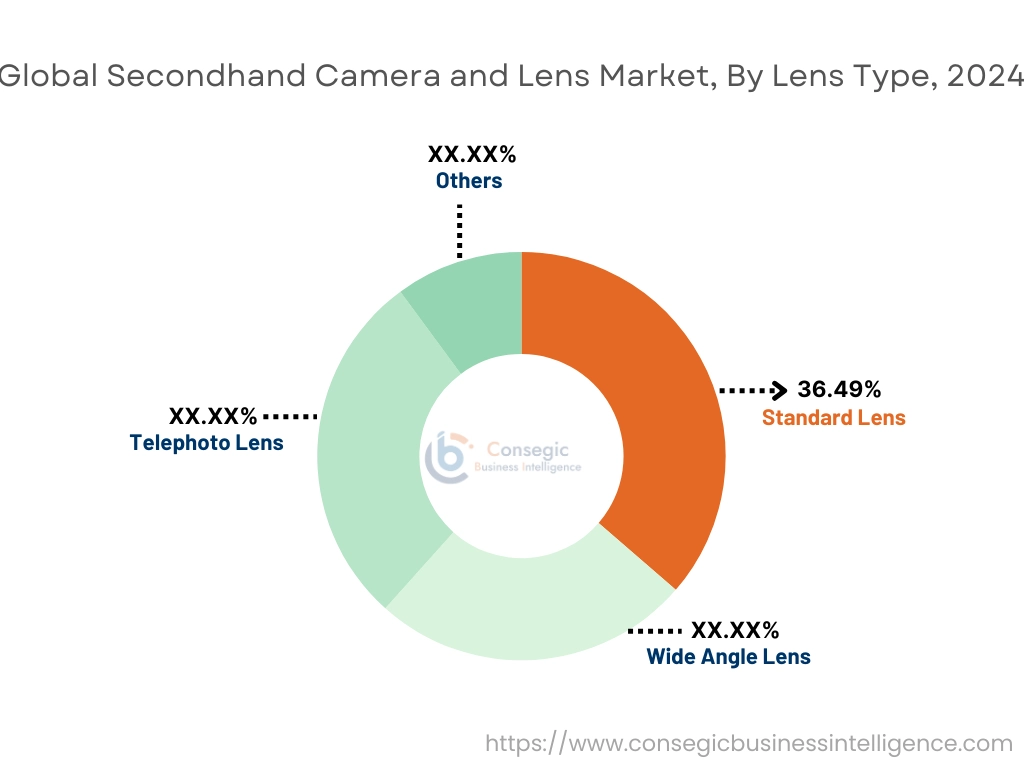
By Lens Mount:
Based on the lens mount, the market is segmented into S-mount, C-mount, CS-mount, F-mount, T-mount, and others.
Trends in the Lens Mount:
- As Sony's mirrorless system gains popularity and more photographers upgrade their gear, the secondhand market for S-mount lenses is experiencing significant growth which in turn drives the secondhand camera and lens market demand.
C-mount accounted for the largest revenue share in the year 2024 and is anticipated to register the fastest CAGR during the forecast period.
- Growing resurgence in the secondhand market due to their unique vintage characteristics and adaptability for use on some modern mirrorless cameras.
- Further, C-mount lenses often offer a cost-effective way for aspiring filmmakers and video enthusiasts to experiment with manual focus and aperture control in turn driving the market.
- Furthermore, price of secondhand C-mount lenses can vary significantly based on their rarity, optical quality, and physical condition, with some collectible lenses commanding high prices.
- Thus, as per analysis, the aforementioned factors are driving the market during the forecast period.
By Focal Length:
Based on the Focal Length, the market is segmented into up to 100 mm, 100 to 200 mm, 200 to 400 mm, and above 400 mm.
Trends in the Focal Length:
- 200 to 400 mm focal length range is crucial for wildlife and sports photography, and the secondhand market offers a more budget-friendly way for enthusiasts to acquire these often expensive lenses which subsequently propels the secondhand camera and lens market expansion.
Up to 100 mm accounted for the largest revenue share in the year 2024.
- This segment, encompassing standard primes and versatile zooms making it an attractive entry point for new photographers.
- Further, as mirrorless systems become more prevalent, there will be a growing demand for smaller and lighter secondhand prime lenses.
- Furthermore, increasing use of vintage manual focus lenses for their unique rendering and tactile experience, drives secondhand camera and lens market growth.
- Thus, dominant availability, increased demand for compact mirrorless primes, and resurgence of vintage manual focus lenses is driving the market.
Above 400 mm is anticipated to register the fastest CAGR during the forecast period.
- Above 400 mm segment demand is driven by the increasing popularity of specialized photography genres like wildlife, birding, and astrophotography.
- Further, buyers in the secondhand market for these lenses will place a strong emphasis on image quality, sharpness, and the overall condition of the lens.
- Therefore, based on analysis, increasing popularity and emphasis on image quality are anticipated to boost the market during the forecast period.
By Price:
Based on the price, the market is segmented into low, medium, and high.
Trends in the Price:
- As professional photographers increasingly adopt mirrorless systems, the demand for high-end secondhand mirrorless lenses increases, which in turn drives the secondhand camera and lens market demand.
- Entry-level mirrorless cameras and lenses are becoming more readily available in the secondhand market at lower prices as newer models are released.
Medium accounted for the largest revenue share in the year 2024 and is anticipated to register the fastest CAGR during the forecast period.
- As the mirrorless market matures, mid-range DSLR cameras and their associated lenses are becoming more affordable on the secondhand market.
- Further, photographers rent mid-range lenses to test them before committing to a new purchase which is driving the secondhand camera and lens industry.
- Furthermore, increasing number of content creators and vloggers seeking specific focal lengths is anticipated to drive the market.
- Thus, as per secondhand camera and lens market analysis, aforementioned factors are driving the market.
By Distribution Channel:
Based on the distribution channel, the market is segmented into online and offline.
Trends in the Distribution Channel:
- Many larger camera retailers and manufacturers offer trade-in programs, allowing customers to exchange their used gear for credit towards new purchases.
- Factors including higher credibility, enhanced customer relationship, and ease of customization are key determinants for driving the offline sales channel.
Online accounted for the largest revenue share in the year 2024 and is anticipated to register the fastest CAGR during the forecast period.
- Platforms dedicated to buying and selling used cameras and lenses are gaining popularity due to their focus on quality control, transparent grading systems, secure transactions, and often, warranty options.
- Further, photography enthusiast communities on social media platforms and dedicated online forums are increasingly used for buying, selling, and trading used gear in turn driving the secondhand camera and lens market expansion.
- Furthermore, some traditional camera stores are expanding their online presence to include a secondhand section in turn driving the market.
- For instance, in October 2022, Incubeta partnered with Adorama to enhance Adorama's digital marketing strategy. Incubeta will provide Adorama with services in paid media, adtech, analytics, and data science, focusing on a full-funnel approach to drive customer acquisition and brand consideration.
- Thus, as per analysis, rise of specialized marketplaces and increased use of social media are driving the market.
By End User:
Based on the end user, the market is amateur photographers, professional photographers, content creators/vloggers, travel enthusiasts, and others.
Trends in the End User:
- The secondhand market offers a range of smaller and lighter camera bodies and lenses that are ideal for travel without compromising image quality, which in turn drives the adoption of secondhand camera and lens.
- Photography students often rely on the secondhand market for affordable cameras and lenses to learn the fundamentals of photography.
Amateur Photographers accounted for the largest revenue share in the year 2024.
- Amateur photographers often look to the secondhand market for budget-friendly options that still offer significant performance improvements over smartphone cameras.
- Further, the secondhand market allows amateurs to experiment with various lens types at a lower cost driving the secondhand camera and lens market.
- Furthermore, many older camera models and lenses still produce excellent image quality which encourage amateurs to buy a used camera.
- Thus, as per analysis, affordability and experimentation with different lens types is driving the market.
Content Creators/Vloggers is anticipated to register the fastest CAGR during the forecast period.
- Content creators often turn to the secondhand market to obtain cameras with better video capabilities and lenses that offer cinematic looks.
- Further, secondhand lenses allow vloggers to experiment with different fields of view to find what works best for their content style.
- Furthermore, content creators seek secondhand lenses with built-in stabilization at more accessible prices.
- For instance, in October 2021, Adorama has launched "Adorama Retail Media" in partnership with Microsoft PromoteIQ. This new program allows Adorama's brand partners to use a self-service and pay-per-click platform to promote their products. Also, this gives brands more control over product visibility and aims to enhance the customer shopping experience.
- Therefore, based on analysis, better video capabilities, experimentation with different focal lengths, and built-in stabilization is anticipated to boost the market during the forecast period.
Regional Analysis:
The regions covered are North America, Europe, Asia Pacific, Middle East and Africa, and Latin America.
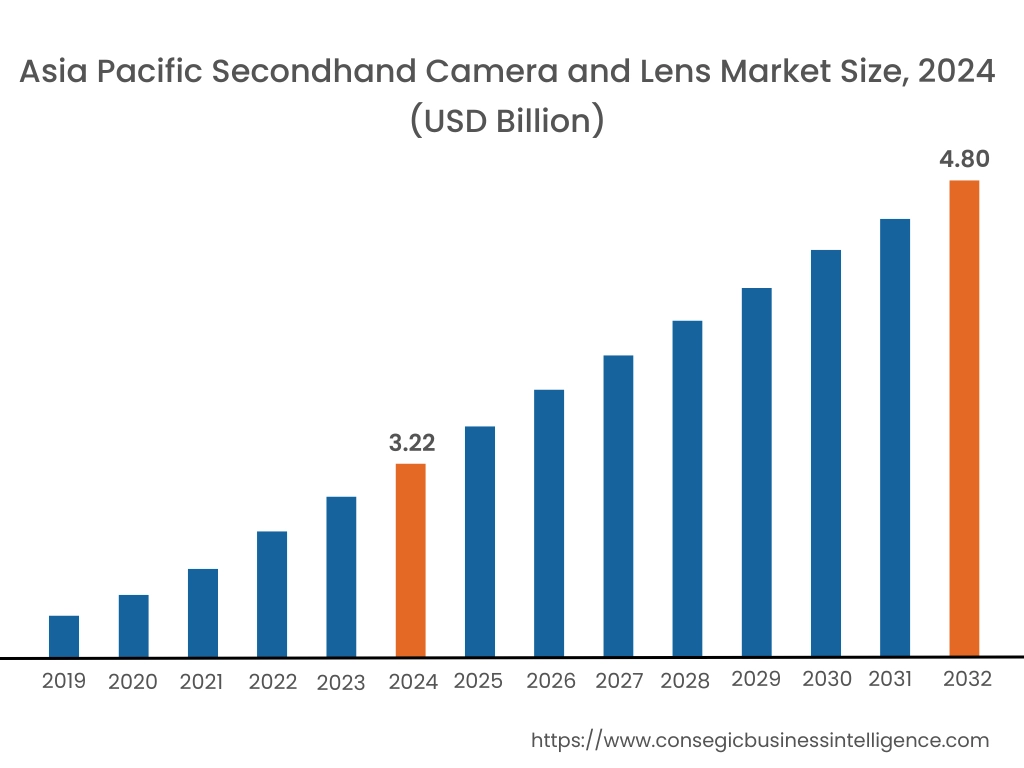
Asia Pacific region was valued at USD 3.22 Billion in 2024. Moreover, it is projected to grow by USD 3.32 Billion in 2025 and reach over USD 4.80 Billion by 2032. Out of this, China accounted for the maximum revenue share of 31.72%. The market for secondhand cameras and lens is mainly driven by increasing affordability and cost savings offered by used equipment compared to new items.
- For instance, SONY ELECTRONICS INC. offers refurbished cameras that undergo a rigorous certification process, ensuring they meet high standards, and these often include a warranty, giving buyers confidence in their purchase. This program provides access to quality Sony equipment at a reduced cost.
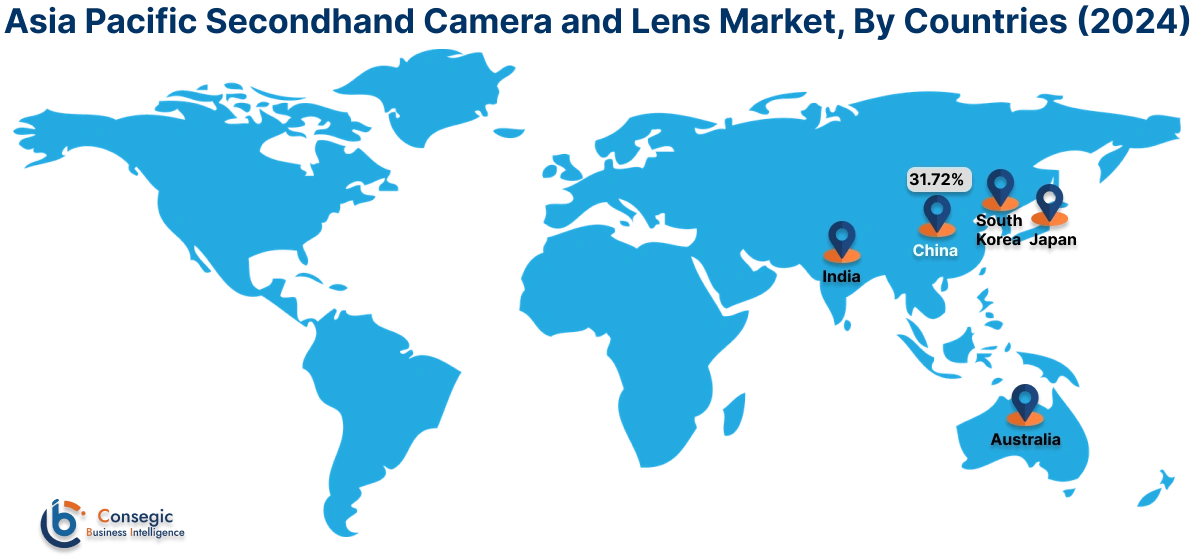
North America is estimated to reach over USD 3.56 Billion by 2032 from a value of USD 2.42 Billion in 2024 and is projected to grow by USD 2.49 Billion in 2025. The North American market is primarily driven by strong consumer culture embracing sustainability and value for money and a mature and well-established online marketplace.
- In November 2021, Adorama acquired Pictar, a mobile photography solutions company. Pictar will now operate as a fully owned subsidiary of Adorama, named Pictar World LLC, while maintaining its independent operation.
The regional analysis depicts that presence of well-established online and offline channels and a strong photography culture in Europe is driving the market. Additionally, the factor driving the market in the Middle East and African region is the growing interest in photography and videography among a younger demographic. Further, price sensitivity among consumers seeking more affordable options for photographic equipment and the increasing adoption of e-commerce is paving the way for the progress of market in Latin America region.
Top Key Players and Market Share Insights:
The global secondhand camera and lens market is highly competitive with major players providing solutions to the national and international markets. Key players are adopting several strategies in research and development (R&D), product innovation, and end-user launches to hold a strong position in the secondhand camera and lens industry. Key players in the global secondhand camera and lens market include-
- Adorama Camera, Inc. (US)
- B & H Foto & Electronics Corp. (US)
- Kerrisdale Cameras (Canada)
- MPB (UK)
- National Camera Exchange (US)
- Nikon (Japan)
- Campkins Cameras (UK)
- Canon (Japan)
- eBay (US)
- FUJIFILM Corporation (Japan)
- Harrison Cameras (UK)
- KEH (US)
Recent Industry Developments :
Partnerships:
- In September 2024, TEAMGROUP partnered with B&H PHOTO to expand its presence in the U.S. creator market. They will focus on providing professional photography and videography solutions, particularly through TEAMGROUP's T-CREATE series, which includes portable SSDs, DRAM, and SSD products.
Secondhand Camera and Lens Market Report Insights:
| Report Attributes | Report Details |
| Study Timeline | 2019-2032 |
| Market Size in 2032 | USD 12.41 Billion |
| CAGR (2025-2032) | 5.1% |
| By Lens Type |
|
| By Lens Mount |
|
| By Focal Length |
|
| By Price |
|
| By Distribution Channel |
|
| By End User |
|
| By Region |
|
| Key Players |
|
| North America | U.S. Canada Mexico |
| Europe | U.K. Germany France Spain Italy Russia Benelux Rest of Europe |
| APAC | China South Korea Japan India Australia ASEAN Rest of Asia-Pacific |
| Middle East and Africa | GCC Turkey South Africa Rest of MEA |
| LATAM | Brazil Argentina Chile Rest of LATAM |
| Report Coverage |
|
Key Questions Answered in the Report
How big is the secondhand camera and lens market? +
The secondhand camera and lens market is estimated to reach over USD 12.41 Billion by 2032 from a value of USD 8.54 Billion in 2024 and is projected to grow by USD 8.80 Billion in 2025, growing at a CAGR of 5.1% from 2025 to 2032.
What specific segmentation details are covered in the secondhand camera and Lens report? +
The secondhand camera and lens report includes specific segmentation details for lens type, lens mount, focal length, price, distribution channel, end user, and regions.
Which is the fastest segment anticipated to impact the market growth? +
In the secondhand camera and lens market, online is the fastest-growing segment during the forecast period.
Who are the major players in the secondhand camera and lens market? +
The key participants in the secondhand camera and lens market are Adorama Camera, Inc. (US), B & H Foto & Electronics Corp. (US), Campkins Cameras (UK), Canon (Japan), eBay (US), FUJIFILM Corporation (Japan), Harrison Cameras (UK), KEH (US), Kerrisdale Cameras (Canada), MPB (UK), National Camera Exchange (US), Nikon (Japan)and others.
What are the key trends in the secondhand camera and lens market? +
The secondhand camera and lens market is being shaped by several key trends including increasing online marketplaces, growing demand for vintage equipment, and a rising focus on sustainability and affordability.
